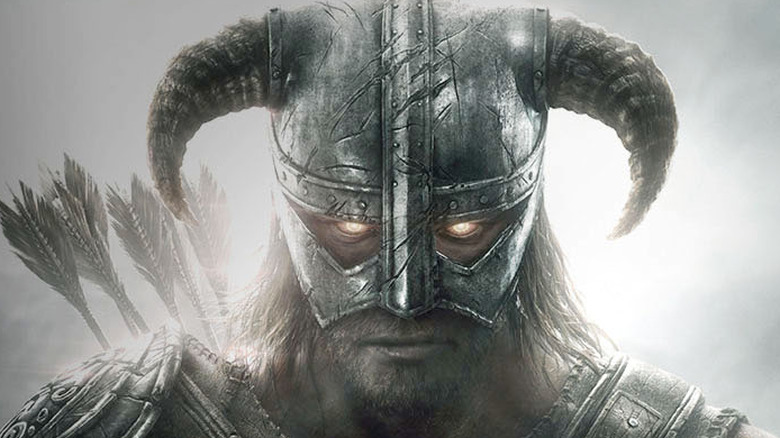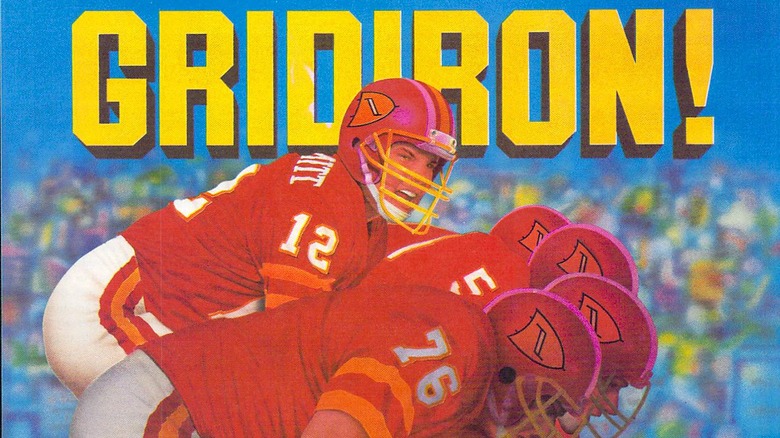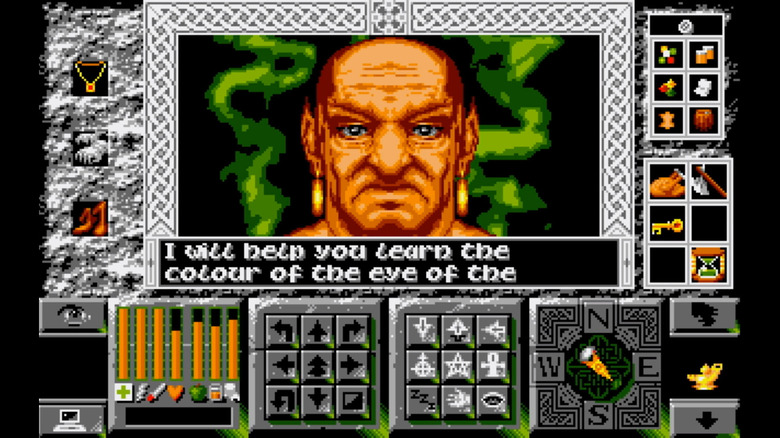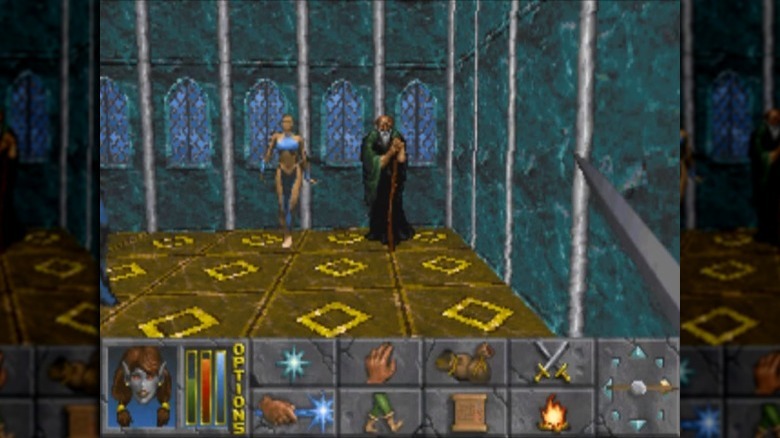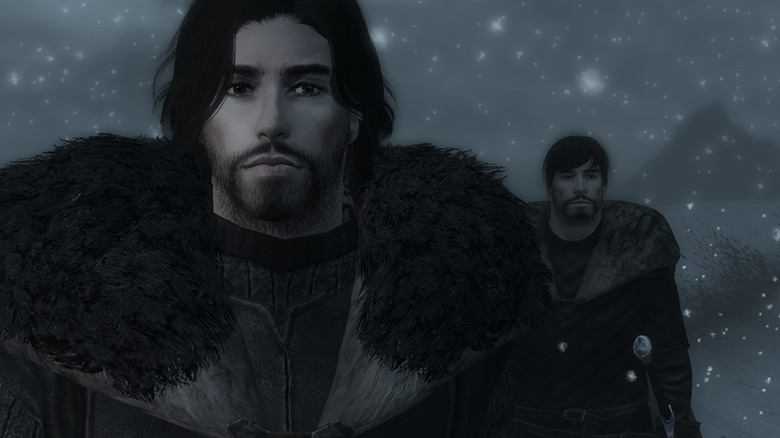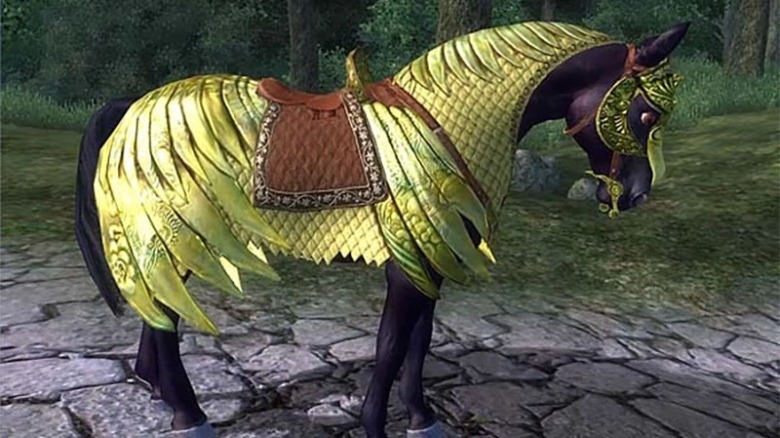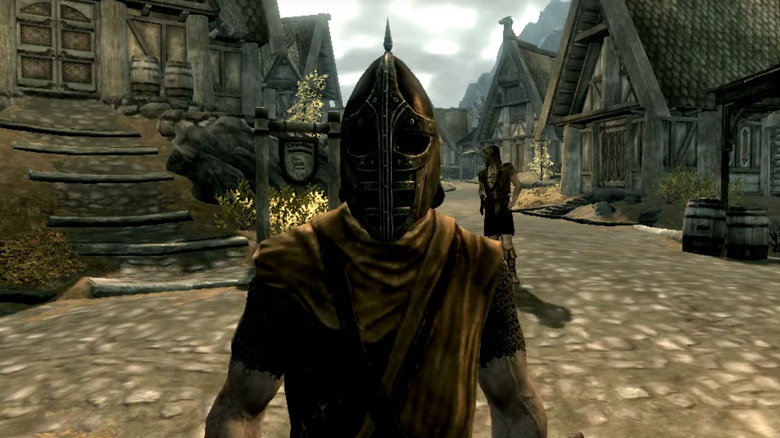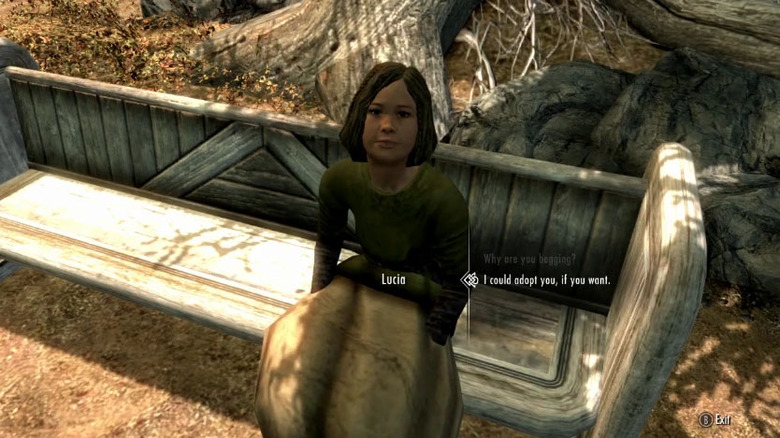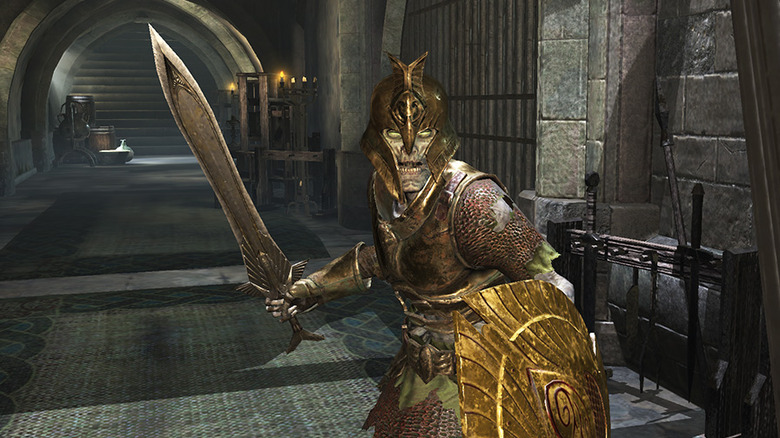The Untold Truth Of The Elder Scrolls
There's no video game world more beloved than Tamriel, the expansive kingdom that serves as the heart of Bethesda's blockbuster role-playing game series, The Elder Scrolls. From Daggerfall to Morrowind to Skyrim to every place in between, players have spent thousands and thousands of hours uncovering long-lost treasures, battling fearsome foes, and going on the grand, open-ended adventures that the games have become famous for. It doesn't matter if you're a fan of single-player epics, MMORPGs, or card games: the world of The Elder Scrolls has 'em all.
Like any well-realized fantasy series, The Elder Scrolls is also packed full of secrets—and not just the ones you'll find tucked away in the games' winding dungeons. It takes a lot of work to put together games as big and immersive as The Elder Scrolls' various entries, and the twists and turns that go on behind-the-scenes are just as gripping as anything you'll see in Tamriel proper. The following stories are just the tip of the iceberg. In true Elder Scrolls fashion, every tale leads to another mystery, and it'd take a lifetime in order to solve them all.
From quarterbacks to Khajiit
Bethesda didn't always make epic role-playing games. The company got its start making sports games, of all things. Bethesda's first big hit was Gridiron!, a physics-based football game that went over so well that Electronic Arts hired the company to make the very first version of John Madden Football (which ended in a lawsuit). A couple of licensed action games and a handful of hockey titles followed.
So, when The Elder Scrolls: Arena rolled around, Bethesda wasn't planning to make an RPG, something that it hard no experience doing. It was going to make an action game, with a healthy dose of sports on the side. As Ted Peterson, one of Arena's two main designers, explains, "The initial idea was that there was a series of tournaments in [an] arena, and your character fought in a team to win the coveted title against other teams."
But Peterson and the rest of the crew started adding RPG-style side-quests set outside the arena and quickly realized that those were more interesting. Eventually, the arena was dropped altogether. Arena's marketing materials had already been printed, however, so someone proposed "the idea that the Empire of Tamriel, because it was so violent, had been nicknamed the Arena." Lead designer Vijay Lakshman tacked on the Elder Scrolls name ("I don't think he knew what the hell it meant," Peterson admits), and one of the biggest franchises in gaming history was born.
The most influential game you've never heard of
The Elder Scrolls owes a big debt to classic role-playing games like Dungeons & Dragons and Ultima. In fact, Ted Peterson cites Ultima Underworld, the first RPG to use 3D graphics from a first-person perspective, as The Elder Scrolls: Arena's main inspiration. There's another game that played a big part in The Elder Scrolls' development, too, although you probably haven't played it. In fact, chances are you've never even heard of it.
Legends of Valour, developed by Synthetic Dimensions, hit PCs in 1992. Like The Elder Scrolls, Legends of Valour is open-ended: players are free to explore the game's single location, the town of Mitteldorf, and its subterranean dungeons while picking up side-quests, hunting for life-sustaining food and drinks, and evading the local authorities.
The only problem? Despite a hilariously over-confident marketing campaign, Legends of Valour isn't very good. Even at the time, Valour paled in comparison to Ultima Underworld, and Peterson admits that "got got pretty pitiful reviews and not many people bought it." Peterson did, though, and "really had fun with it. It's completely forgotten nowadays, but I probably logged more hours playing it than any other game." These days, Legends of Valour might be little more than a curiosity, but its influence lives on in The Elder Scrolls. All things considered, that's a pretty decent legacy.
Skyrim ain't the biggest
The Elder Scrolls V: Skyrim might feel like one of the biggest and most detailed virtual worlds ever brought to life, but compared to its predecessors, it's small potatoes. Skyrim's main map is 14.79 square miles in size. The Elder Scrolls III: Morrowind, meanwhile, is a paltry 9.3 square miles, but that makes sense: Morrowind is confined to a single island, and doesn't really venture onto the larger mainland.
All of this pales in comparison to The Elder Scrolls II: Daggerfall, however. That map isn't just big. It's gargantuan. At 62,394 square miles, Daggerfall is bigger than half of the states in America or the entirety of England. If you want to walk across it — and yes, people have tried — it'll take you over 60 straight hours. Daggerfall isn't as large as games like No Man's Sky or Elite: Dangerous, which use algorithms to simulate entire galaxies, but it's still pretty darn huge.
Don't go wandering across Daggerfall expecting a never-ending stream of things to do, though. Unlike later Elder Scrolls games, which have maps that are handmade, Daggerfall's expansive terrain is mostly procedurally generated. That means that it's made mostly by formulas, not game designers. As a result, Daggerfall is big, but it's also fairly barren. By contrast, Skyrim might be a lot smaller, but it's packed with things to do. Maybe — just maybe — size really doesn't matter.
How the Elder Scrolls ruined Bethesda — and how they saved it
Sales-wise, positive word-of mouth made The Elder Scrolls: Arena a modest success, while Daggerfall was an immediate hit, shipping 120,000 units at launch — way more than Bethesda expected — and selling out at retailers all over the world. The next Elder Scrolls games, on the other hand, didn't do so well. In an interview with the German outlet Gamestar (by way of Kotaku), Bethesda's Todd Howard says that, following Daggerfall, Bethesda's team took on too many projects. An Elder Scrolls Legend: Battlespire and The Elder Scrolls Adventures: Redguard might've taken place in the same world as Arena and Daggerfall, but critics didn't give them the same kudos, and they didn't really sell.
That put Bethesda in a world of hurt. Bethesda considered filing for bankruptcy, and was bought by the last minute by ZeniMax Media. Still, the buyout didn't guarantee Bethesda's long-term survival: Morrowind did. "Once you get to that point, there was this element of no fear," Howard says. "Well, let's go all in. This is the game. Let's put all our chips on the table." The results speak for themselves. Morrowind transformed Bethesda into one of the video game industry's biggest developers; Skyrim has sold over 30 million copies alone.
The Elder Scrolls: Westeros
Tamriel, the fantasy kingdom where The Elder Scrolls takes place, isn't your typical video game setting. It's a remarkably detailed world with a complex history, multiple libraries' worth of in-game books to read, and a nearly neverending stream of characters to meet. If you want to read all of The Elder Scrolls' in-game texts (which you can totally do), carve out a chunk of time. The collection is thousands and thousands of pages long.
That sounds an awful lot like another popular fantasy franchise, and that's before you add in the dragons. George R. R. Martin's A Song of Ice and Fire, better known these days as Game of Thrones, is similarly dense. Martin's people must've noticed the similarities between The Elder Scrolls and Thrones, too, because sometime between Oblivion and Skyrim, Martin's representatives pitched Bethesda on making an official Game of Thrones adaptation.
"With A Song of Ice and Fire, we went 'We want to do that!'" Todd Howard says. "They thought it would be a good match—and so did we, actually—but then we thought about if that was where we wanted to spend our time." It wasn't, so Bethesda passed. Still, in a way, we got the best of both worlds: while Bethesda went on to make Skyrim instead, fans have ensured that Elder Scrolls players can travel to King's Landing, the Wall, and beyond thanks to all kinds of Game of Thrones-themed mods.
Maybe that horse armor wasn't so dumb after all
Anyone who's spent time on the gaming internet knows about Oblivion's much-maligned horse armor. It is, quite simply, one of the biggest jokes in modern video games.
In 2006, the company put some marginally cool looking but functionally worthless horse armor up on the Xbox Live marketplace, asking fans to pay a cool $2.50 to deck out Oblivion's digital steeds. If you think that's kind of a lot you're not alone. To this day, "horse armor" is still shorthand for overpriced and frivolous downloadable content.
Well, guess what? The joke's on you. Not only did horse armor help Bethesda streamline its DLC pipeline, paving the way for Oblivion add-ons like Knights of the Nine and The Shivering Isles, but it sold well. Really, really well. People were still buying horse armor in March 2011, five years after the DLC pack was first released. Bethesda director Todd Howard calls the equine apparel "one of the most popular [DLC packs] we've done." In fact, Howard says, in a world where players scramble for new Grand Theft Auto Online outfits and fresh Fortnite skins, the horse armor was actually ahead of its time. Take that, whiners!
The mysterious origins of that arrow in the knee
You know it, you love it, so everyone say it with us: "I used to be an adventurer like you, then I took an arrow in the knee." Skyrim's most infamous line has become more than a mere meme. It's a pop culture institution. The widely parodied dialogue has popped up in places as varied as an LMFAO music video and an episode of NCIS — you know, that CBS procedural that your grandparents love? So, yeah, that's big time.
And yet, where did the line come from? There are a few competing theories. A popular meme says that taking an "arrow in the knee" is actually Norse slang for getting married. Ever wonder why men get down on one knee to propose? According to the meme, that's why. No less of an authority than Pete Hines, vice president of Bethesda itself, says that the line is a reference to Patrick Rothfuss' fantasy novel Name of the Wind.
There's just one problem with those explanations: they're both wrong. Bethesda writer Emil Pagliarulo, who penned the line, explains: "At that time, I was writing dozens of lines for the town guards in Skyrim. Just to give them flavor and personality." When it became a catchphrase, Pagliarulo says, "I was pretty shocked." He's not alone.
The name is Kiin, Dovah-Kiin
Sure, you like The Elder Scrolls, but do you love it enough to name your kid after it? One couple does. In the lead-up to Skyrim's release on November 11, 2011, Bethesda made a special offer to families whose child ended up being born on the special day — and Eric and Megan Kellermeyer decided to call the studio's bluff.
The same day that Skyrim first appeared in the wild, young little Dovahkiin Kellermeyer made his way into the world. For those of you not in the know, Dovahkiin translates to "Dragonborn" in Elder Scrolls lore, and refers to a human who has a dragon's soul. Young master Kellermeyer, who goes by "Dovah," may not have any supernatural powers, but mom says that he's pretty proud of his unique name, even if he's a little too young to jump into Skyrim himself.
Of course, there's a method to this madness. Bethesda gave the Kellerman's a lifetime supply of its games, which father Eric has "put ... to good use." Megan, meanwhile, isn't much of a gamer, but she has absolutely no regrets about the decision. Not only was Dovahkiin "the perfect name," Megan says, but she's enjoyed being part of the larger Elder Scrolls community. "Seeing anything Elder Scrolls is like recognizing a friendly face," she says. "I have never looked back."
The Elder Scrolls: Blades isn't the first
In 2003, a full 15 years before The Elder Scrolls: Blades made its E3 debut, a company called Vir2L released a handful of mobile games carrying the Elder Scrolls branding. Apparently, four games were released under the The Elder Scrolls Travels banner: Stormhold, Dawnstar, Shadowkey, and Oblivion. Each of the first three games took place in a first-person perspective, and different versions of the game were created to make sure the game could be played on as many different devices as possible. The smallest edition of Stormhold had a mere eight dungeons, while the largest boasted 36.
Each one took place in a single location — Dawnstar is an "exile post" in the far north, for example, while Oblivion focused on Tamriel's capital, Cyrodiil — and Shadowkey also facilitated two-player co-op via Bluetooth. You controlled the games by pressing buttons on your phone's physical keypad, so, yeah, these games are pretty old.
They're also not very good, which is probably why the fourth entry in the franchise, the Sony PSP-exclusive The Elder Scrolls Travels: Oblivion, ended up canceled. You can still find beta versions of Oblivion online, but be warned: over the years, Bethesda and ZeniMax have been extremely aggressive when it comes to keeping the unfinished game a secret. If you want to try it, you're going to have to look pretty hard.
Dovahzul, the dragon language you can speak at home!
If you've played Skyrim, then you've definitely run across Dovahzul, or "the dragon language." Those magic words that your character yells to breath fire, slow down time, or summon a dragon? They're all Dovahzul. Unlike many other fantasy languages, Dovahzul isn't just a collection of noises that sound good together. It's a fully-functional language put together by Bethesda senior designer Emil Pagliarulo, with a little bit of help from concept artist Adam Adamowicz.
Dovahzul wasn't easy to make, either. Bethesda's team wanted Dovahzul to be flexible enough to support multiple uses, including Skyrim's orchestrated main theme. That meant making a language that could rhyme in translation from English lyrics, and that was complicated enough to sound authentic while remaining easy to learn and speak. Pagliarulo started by studying Old English, specifically as it's found in the medieval epic Beowulf, and then started paring down the rules to keep things simple. Unlike English, for example, Dovahzul verbs don't have tenses.
Adamowicz helped Pagliarulo come up with Dovahzul's written form, which consists of a 34-letter alphabet, each of which represents a unique sound. Written Dovahzul looks a lot like ancient cuneiform, but it's actually got a different source of inspiration: the dragons themselves. "How would the dragons write or scratch this language in the stone or on the ground?" Todd Howard muses. "Everything is done with the three talons." That includes writing, too.

